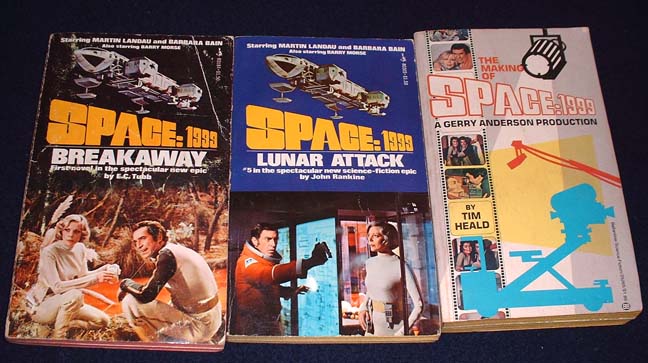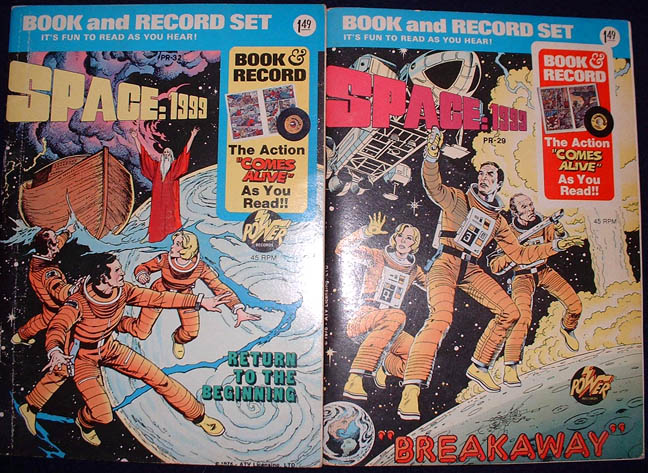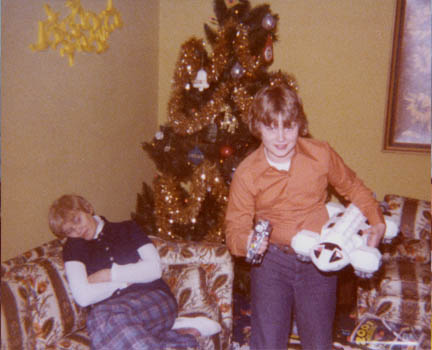 After Vince started his crusade to bring me around, I watched another episode called The Guardian of Piri, which involved the personnel of Moonbase Alpha being lured to a planet where they are basically turned into listless dolts who sit around and stare into space. Not exactly exciting stuff for an 11-year-old, and I was convinced this show was a dud. Finally, I figured I’d give it one more try for Vince’s sake, so I picked up one of the Space:1999 books which novelized four episodes of the show into one sort of cohesive story. Written by veteran science fiction writer E.C. Tubb, I was impressed by the story and I finally understood what I couldn’t seem to grasp by merely watching a random episode here and there.
After Vince started his crusade to bring me around, I watched another episode called The Guardian of Piri, which involved the personnel of Moonbase Alpha being lured to a planet where they are basically turned into listless dolts who sit around and stare into space. Not exactly exciting stuff for an 11-year-old, and I was convinced this show was a dud. Finally, I figured I’d give it one more try for Vince’s sake, so I picked up one of the Space:1999 books which novelized four episodes of the show into one sort of cohesive story. Written by veteran science fiction writer E.C. Tubb, I was impressed by the story and I finally understood what I couldn’t seem to grasp by merely watching a random episode here and there.
While Star Trek presented a bright future where outer space was a dynamic and exciting place to explore, Space: 1999 presented a darker vision where man’s inability to control his own technology had thrust a sampling of humanity into the dark, cold, inhospitable void long before they were psychologically ready to face it. The
 During the spring and summer of 1976, I watched both Star Trek and Space: 1999. They were like two sides of a space opera coin. Star Trek stimulated my desire for adventure and exploration; Space: 1999 compelled me with its sense of loneliness and danger. And just like every kid who’s rabid about a t.v. show, I piled up Space: 1999 toys and memorabilia just as quickly as I did for Star Trek. Peter Pan records put out two Space: 1999 book and record sets, along with an LP of audio stories. I also had the Mattel version of the Commander Koenig action figure, and a cardboard representation of Moonbase Alpha with cardboard people and spaceships.
During the spring and summer of 1976, I watched both Star Trek and Space: 1999. They were like two sides of a space opera coin. Star Trek stimulated my desire for adventure and exploration; Space: 1999 compelled me with its sense of loneliness and danger. And just like every kid who’s rabid about a t.v. show, I piled up Space: 1999 toys and memorabilia just as quickly as I did for Star Trek. Peter Pan records put out two Space: 1999 book and record sets, along with an LP of audio stories. I also had the Mattel version of the Commander Koenig action figure, and a cardboard representation of Moonbase Alpha with cardboard people and spaceships.
Also, just like Star Trek, I bought up all the model kits available, including the Eagle and Hawk spaceships, and the Moonbase Alpha diorama. AMT even put out a dune buggy looking thing called The Alien and slapped the Space: 1999 logo on it. Although it had nothing to do with the show, I bought it anyway.
I mentioned the novels earlier, but there were also comic books (great early John Byrne artwork), coloring books, and even a color-by-number poster. If the Space: 1999 logo was on it, I was buying it.
 For Christmas 1976, I received the laser gun, complete with flashing lights, and the three-foot Eagle spaceship with little Koenig, Russell, and Bergman figures. They were kinda brittle and posed in a strange, ape-like stance to fit in the cockpit, so I soon abandoned the figures and used my MAC men (more on that in a previous post). These items, like virtually all the Space: 1999 stuff, were based on the characters and look of the first season. In the fall of ’76, Space: 1999 was into its second season and it appeared to be almost a completely different show.
For Christmas 1976, I received the laser gun, complete with flashing lights, and the three-foot Eagle spaceship with little Koenig, Russell, and Bergman figures. They were kinda brittle and posed in a strange, ape-like stance to fit in the cockpit, so I soon abandoned the figures and used my MAC men (more on that in a previous post). These items, like virtually all the Space: 1999 stuff, were based on the characters and look of the first season. In the fall of ’76, Space: 1999 was into its second season and it appeared to be almost a completely different show.
To make the show more “American,” Gerry Anderson brought in t.v. hack Fred Freiberger, who had produced the disastrous third season of Star Trek. To Freiberger’s credit, he did make the show more exciting, hiring writers and directors who could focus on action and pacing. He also allowed the set and costume designers to bring more color and flair to the show’s look. He specifically moved away from the expansive, white sets of the first season in favor of smaller rooms crammed with equipment to enhance tension. Freiberger’s flaw was that he viewed Space: 1999 as another Star Trek, and completely ignored the tone and story lines that made the show unique. Instead of encountering advanced beings and space phenomena that challenged their perception of the universe, Koenig and the gang spent the second season battling the proverbial bug-eyed monsters who were usually bent on stealing Alpha’s “life support core,” whatever the hell that was. He also callously removed characters and replaced them with new ones, never explaining where they went. On Star Trek, you could assume that characters like Yeoman Rand were simply transferred, but characters stranded on a runaway moon had to be explained away. I guess Freiberger assumed we were too stupid to notice.
Which was the essential flaw with the second season: the fans were treated like clods who only wanted spaceships and ray guns. For all its shortcomings, the first season had a point of view. In addition to showing humans at their best and worst under stressful conditions, presenting alternate perceptions of reality, and building suspense through the sheer struggle to survive, there was also an underlying theme that promoted the concept that the Alphans had a destiny. Man had destroyed Earth through wars and pollution and the inhabitants of Moonbase Alpha were flung into the cosmos to provide the human race with a second chance to start over on a new planet. Sometimes they would inexplicably escape certain destruction. The only reason for their survival was that some higher power wanted them to carry on and fulfill their destiny. Pretty heady stuff for 70s t.v.
Of course, as a pre-teen, I only understood these concepts on a subliminal level. Watching the second season, an inexplicable sense of loss grew as each new episode aired. With each new bug-eyed monster, I was certain something special was missing. I couldn’t articulate it, but I yearned to see the first season again. Unlike Star Trek, however, Space: 1999 was in first-run syndication, meaning that the first season shows would not be rerun for some time if at all. The Year Two episodes became steadily worse as the weeks went by and I gave up on the show completely before the run of new episodes was completed. I didn’t even bother to check if there would be a Year Three, the writing on the wall was so clear.
They did syndicate the reruns during the late 70s, but I had moved on. I suppose it was symbolic that I dismantled my Space: 1999 models to make customized spaceships and Vince and I blew up his Moonbase Alpha model with firecrackers. Boys will be boys. It wouldn’t be until the real year 1999 rolled around that my interest in the show would resume.




No comments:
Post a Comment